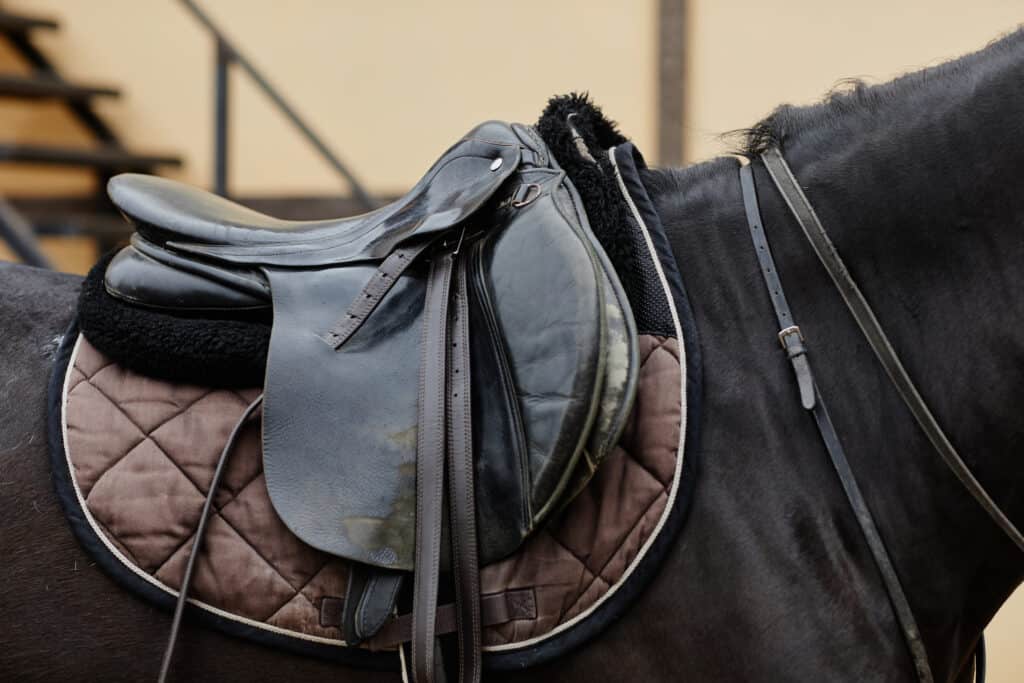How much a horse saddle weighs will vary based on the design, use, and materials involved in its construction. Generally speaking, English saddles are lighter than Western saddles because they’re smaller and more streamlined for activities like jumping.
Ultra lightweight saddles can weigh as little as 8 pounds, while the heaviest saddles can easily clear 50 pounds.
The construction and materials used can greatly affect how much a saddle weighs. More material will obviously increase the tally. Leather is particularly heavy compared to synthetic materials. The materials used to create the saddle tree and the structure of the saddle can also influence average weights.
The weight of the saddle can affect the comfort of both the horse and the rider, so make sure to consider both when you’re searching for the right match. Having an English saddle or Western saddle that doesn’t fit you or your horse can even lead to injuries.
Remember that not all horses will be able to wear the same saddles or carry the same amount of weight. A horse with back issues might need a lighter saddle. Your horse’s comfort should always be a key factor in buying or choosing a saddle.
The Weight Of Western Saddles
So, how much does a Western saddle weigh? Western-style saddles will almost always weigh more than English saddles because of how they’re designed and what they’re used for. The weight of a western saddle is important for added durability and comfort, and leather is the traditional material.

Since the people who originally came up with the Western saddle were often traveling long distances and needed to carry saddle bags, they couldn’t rely on the lighter saddle designs typical of English riding.
Over time, the Western saddle continued changing, including when the horn was added to help with roping cattle and managing livestock. This required a heavier saddle with a strong tree and horn that could withstand the demands of ranch work. As a result, heavy Western saddles became the norm.
The Western saddle further branched out to distinguish between specialty categories. A roping saddle, for example, will be stockier and more durable than an ordinary Western saddle meant for pleasure riding since ranch saddles are subjected to more force and wear on a daily basis.
Western riding as a discipline tends to be less conventional than English riding. A rider can easily decide to add decorative elements or more leather. Since leather is quite heavy, this can be an unexpected source of pounds that doesn’t contribute to a meaningful function like keeping the horse or rider comfortable.
The Weight Of English Saddles
If English saddles are lighter than Western saddles as a general rule, how much less does an English saddle weigh? As you might have gathered by now, the exact range will vary based on the style of the saddle. Racing saddles and jumping saddles can be quite lightweight since extra weight makes those activities more challenging.
Otherwise, saddle weight for a non-racing saddle will weigh around 15 or 20 pounds for most English saddles. Dressage saddles in particular tend to be at the higher end of that range, or even as high as 25 pounds, because of how they’re designed.

Unlike jumping or racing saddles that are meant to improve freedom of movement, dressage saddles emphasize control over the horse. They usually have longer flaps and a higher pommel, which adds material and weight to the saddle.
Matching Horses And Saddle Weights
The right type of saddle for each horse will depend on the animal and the activity in question. There’s no one-size-fits-all type of saddle that works better or worse than another. Instead, horse owners need to consider a variety of factors while choosing which type of saddle to buy.
Many people believe that lightweight saddles are preferable because they’re easier for horses to carry and allow for the better overall movement. Others believe that heavier saddles are better because they’re less likely to shift and they have more stability. The truth is likely somewhere in the middle since the weight of the saddle is only one factor.
Using the wrong saddle weight for a horse can contribute to poor overall fit for both Western saddles and English saddles. This can negatively affect the horse’s comfort and potentially even lead to injury. For example, a heavier saddle that doesn’t fit properly on the horse’s back could cause saddle sores to form from additional pressure and friction.
Injuries are most likely to occur with a working horse that wears a saddle daily. If the saddle fits improperly, the horse won’t have enough time to recover if they’re working daily instead of going on an occasional ride. A new saddle may also have a breaking in the period while the leather conforms to the horse.
In addition to the weight of the saddle, you should also consider the weight of other materials, accessories, and tack. A saddle pad might not weigh that much extra, but saddle bags can affect how the saddle distributes weight and make the saddle heavier for your horse.
Plus, after calculating how much weight is there from equipment, you also have to think about your own body weight as the rider. Something as simple as the boots you’re wearing can add weight unexpectedly, which could feel more impactful to a smaller horse.
As you ask your horse to carry more weight, you should be more mindful about what else adds weight on top of your initial calculations. For example, leather that gets wet can weigh substantially more than dry tack.
Final Thoughts
Saddles are frequently subject to a rider’s preferences and the conventions of the discipline. Western saddles are almost always heavier than their English counterparts.
Most Western saddles are around 30 pounds, but they can be as light as 8 pounds or as heavy as 60. An English saddle will usually fall within the range of 15–25 pounds.
The ideal weight for each discipline depends on what you need. A Western saddle for short-distance trail rides doesn’t need to be as heavy or robust as a Western saddle used for roping. Similarly, an English saddle that works for dressage might be too heavy for jumping.
It’s also important to consider what a saddle was originally intended to do. The Western saddle evolved because of the need for stronger saddles, but not all Western saddles are used for that purpose today. Plenty of people use Western saddles for pleasure riding as well.
Overall, saddle weight is a critical factor for both English and Western riders. Even a saddle of average weight can cause stress or injury if it’s not the right fit for the horse. From close contact saddles to all-purpose saddles, you should always make sure saddles properly distribute weight and accommodate the rider’s movement.
Frequently Asked Questions (FAQ):
Will An English Saddle and Western Saddle Weigh the Same?
No, an English saddle typically weighs less than a Western saddle since it’s smaller in size and doesn’t need to withstand the same demands as ranch work or Western events like cattle roping. In fact, some Western saddles weigh twice as much as English saddles.
How Much Does A Stock Saddle Weigh?
An Australian stock saddle averages around 20 to 25 pounds, but they can weigh as much as 40 pounds for heavier models. This type of saddle combines many traits of the English and Western saddle styles, so the weight of a stock saddle tends to fall in the middle as well.
What Is the Lightest Kind of Saddle?
An exceptionally lightweight saddle can weigh as little as 8 or 9 pounds. These kinds of saddles are often marketed toward endurance riders, barrel racers, and participants in long-distance races. Lightweight saddles are more likely to favor synthetic materials that weigh less than traditional options like leather.



